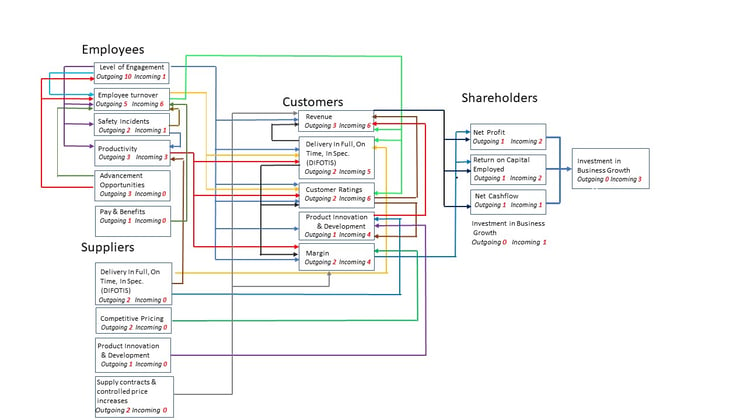By mapping how the KPIs for your key stakeholder groups connect and feed into each other to produce business performance, your managers will be able to predict what will happen when performance on these KPIs change.
Most KPIs are Used to Measure the Performance of Individual Team Members
Managers are familiar with using Key Performance Indicators (KPIs), but mainly as a tool to measure the performance of individual members of their team. These KPIs relate specifically to their role and the particular tasks and processes they undertake or contribute to. In the best continuous performance management systems, an online conversation between the manager and the individual goes on throughout the year to discuss progress, give feedback, and provide advice and coaching. The aim is for the manager to coach and support the individual to be successful in delivering their KPIs. Whether a continuous conversation occurs throughout the year or not, managers usually look back at the end of the year at what has been achieved and compare it to the KPIs that were set.
KPIs for Stakeholder Groups Can Provide Levers for Managing the Business
But KPIs can also be developed for key stakeholder groups of the organisation as well as individual team members. When developed at this level they can provide much more than a rear vision view of performance.
Defining the key measures of company performance (such as net profit, return on capital employed, net cashflow and others) and then defining the KPIs that each stakeholder group contributes to the achievement of these not only provides a map of how the business works but it allows leaders to see and understand how the performance of stakeholder group KPIs interact with each other to deliver the end result.
As this understanding increases, leaders learn how performance on each KPI affects performance on the others and ultimately affects the company performance. For example, as employee engagement rises, productivity increases, quality defects reduce, and customer loyalty increases. This then gives the process of managing performance a whole new dimension as it enables managers to look forward and know what will happen as the performance on individual KPIs change and which causes need to be addressed to maximise the overall company result.
Developing and Tracking Stakeholder Group KPIs is a Simple Mapping Process
Setting up this process requires a few simple steps that any leadership team can easily complete. The objective is to set up a chain of predictive numbers that allow you to regularly forecast the company performance and decide what actions to take to optimise it.
Firstly, Identify the Company’s Key Stakeholders
A stakeholder is any individual, group, or party that has an interest in an organization and the outcomes of its actions. Common examples of stakeholders include employees, customers, shareholders, suppliers, communities, and governments. Different stakeholders have different interests, and companies often face trade-offs in trying to please all of them. This excellent HBR article Five questions to identify key stakeholders will help you focus on the relationships that matter most.
Let’s assume in our example that the key stakeholders are employees, suppliers, customers, and business owners/shareholders.
Create KPIs for Each Key Stakeholder Group
The next step is to identify the key relationships between the company and each stakeholder group that create value.
The company wants something from its stakeholders that provide value and in return, the stakeholders want something from the Company. Value can only be created if both sides get benefit from their relationship and this means there must be KPIs which measure the benefits for both the company and each stakeholder group. Just a reminder here that these KPIs are for a stakeholder group, not for individual members of the group. They are KPIs that apply to all members of the group. The KPIs for the customer stakeholder group would be a mix of the things that the company wants from all of its customers and those that all customers want from the company. They are at a higher level than the KPIs that individuals have.
Some examples
Companies want people to be engaged because research has shown it increases productivity, profitability and customer ratings and reduces quality defects, safety incidents, employee turnover and shrinkage.
Employees also want to be engaged because it means they know what is expected of them at work and have the materials and equipment to deliver it. They have the opportunity to do meaningful work they are good at and are recognised for it. They are encouraged to develop and grow their capabilities. Their supervisor cares about them as a person and their opinions count. They feel their job is important and they work with people who are committed to doing quality work.
A KPI on the level and growth in employee engagement captures all of these elements. Specific KPIs on particular elements such as safety incidents, staff learning and development and staff turnover also benefit both employees and the company.
From customers, the company wants KPIs such as revenue, gross margin, and client ratings of company performance. Customers want measures around DIFOTIS (Deliveries in full, on time in specification), product development and customer service.
From suppliers the company wants KPIs such as DIFOTIS, competitive pricing, customer service and availability of supplies versus orders. Suppliers want KPIs around supply contracts, lead times and average order quantities.
Business owners/shareholders want KPIs around Profit, ROCE, net cashflow and debt/equity ratio
Mapping the Relationship between KPIs
Stakeholder Group (SHG) KPIs interact and affect each other. Understanding how these interactions work enables managers to understand how the overall performance of their company is created. It allows managers to look forward and predict what will happen as performance on the SHG KPIs change and which ones to address to fix issues and maximise overall performance.
Mapping the relationships between KPIs is a simple process that can be done by the leadership group. The technique is to develop an Interrelationship Diagram which shows the cause and effect relationships amongst all the SHG KPIs.
Developing the Interrelationship Diagram
The technique is simple:
- Write the name of each stakeholder group in roughly a circle on a whiteboard. As a group, discuss and agree the KPIs for each. List each of their KPIs under their SHG name
- Point to the first KPI of any stakeholder group and point to the first KPI of any other group. Ask the question “does either of these two KPIs cause or influence the other?”
- Discuss the two as a group and decide if either causes or influences the other. If there is a relationship, draw an arrow from the KPI that is the influencer or cause to the KPI that is affected. As an example, suppose we are comparing the KPI of Employee Engagement in the Employee SHG the with the KPI of Customer Satisfaction Rating in the Customer SHG. It is well researched that employee engagement has a direct effect on customer satisfaction rating so the arrow goes from employee engagement to customer satisfaction rating as shown.

- Continue to compare each KPI with every other KPI, repeating the question and drawing the arrows in the appropriate direction. If there is no cause and effect relationship between them simply move on to the next pair. You will end up with a diagram that looks like the one below.
- For each KPI, count the number of outgoing arrows and the number of incoming arrows and put the totals for each under each KPI as shown in the diagram.
- The KPIs with the most outgoing arrows are the root causes or drivers. The ones with the most incoming arrows are the key outcomes or results

What the Interrelationship Diagram Shows
Firstly, the arrows show how KPIs connect and feed into each other to deliver outcomes. For example, engaged employees cause DIFOTIS to happen on a regular basis which in turn causes customer ratings to increase which cause margins and revenue to increase. Understanding the effects each KPI has on others builds an understanding of the business and enables managers to predict likely outcomes when performance on each KPI improves or declines.
Secondly, it shows the key drivers (the ones that have the most outgoing arrows) that have the biggest effect on the key outcomes. In our example above the key driver that has the biggest influence on a number of other KPIS is employee engagement. The key drivers have the most influence and are therefore the ones that it is critical to focus on, manage and get right.
The KPIs with the largest number of incoming arrows are key outcomes that must be measured and managed constantly. They are the key outcomes that must be done well to ensure the financial performance numbers of the business are delivered.
In our example they are employee turnover (6), revenue (6), customer ratings (6) and DIFOTIS (5). By understanding what causes these to change, managers know where action needs to be taken when they see the critical measures change.
How Often KPI Performance is Measured and Reported is Determined by the Shareholder KPIs
In his excellent Harvard Business Review article entitled KPIs Aren’t Just About Assessing Past Performance Graham Kenny makes the point that once you have decided the frequency with which the Shareholder “final outcome” KPIs such as profit, ROCE and net cashflow are measured, then all the KPIs to the left of them in the interrelationship diagram must be measured at least as frequently if they are to be useful in predicting outcomes and improving performance. If the financial KPIs are reported monthly then, for maximum usefulness, all the other KPIs must be measured at no longer than monthly intervals. Sensitive or volatile KPIs can be measured more frequently than monthly, but not longer. If, for example, you only measure employee engagement annually it is not going to be a useful predictor of any of the KPIs that drive monthly profit.
Understanding the Business and Predicting Outcomes
The interrelationship diagram enables managers to see and understand how the business works. By understanding how the KPI relationships work and measuring them at a frequency that allows people to see what makes a difference opens up a whole new set of possibilities and opportunities.
Brian Shaw is a Director and Co-Owner of Mariner7. He has been a Group HR Manager, Company and Regional Manager with Alex Harvey Industries/Carter Holt Harvey in New Zealand and overseas. He was a partner in the international consulting firm PA Consulting Group, specialising in strategy development, business transformation and the implementation of major change projects in a variety of industries around the world.


